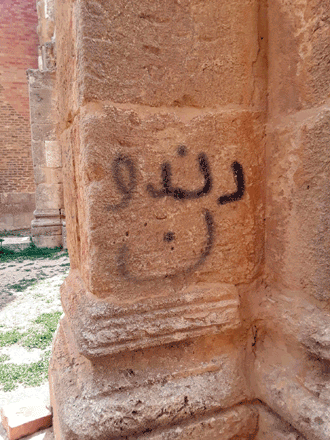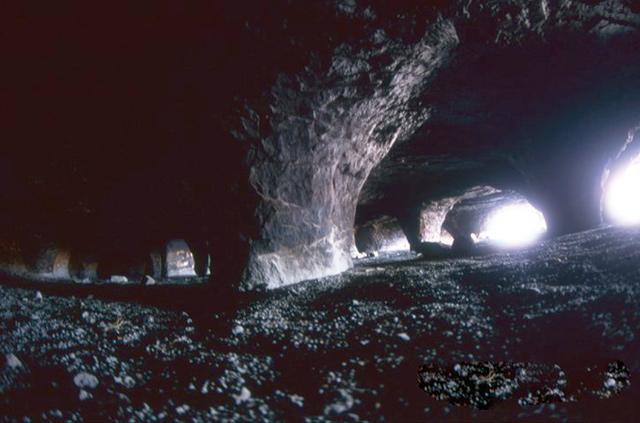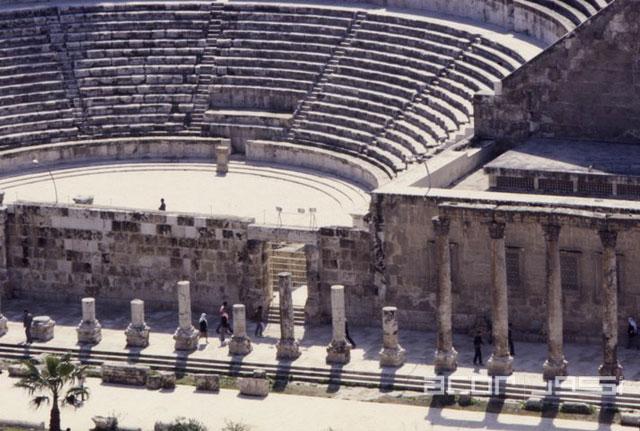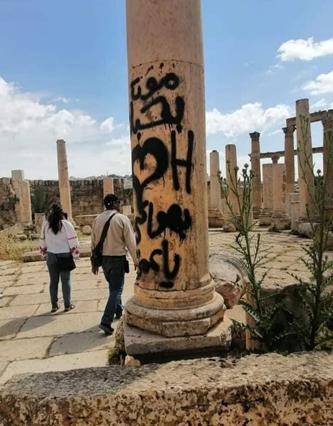You are here
Jordanian archaeologist offers suggestions for protecting sites from vandalism
By Saeb Rawashdeh - Apr 26,2023 - Last updated at Apr 26,2023

A recent vandalism at Qasr Mushatta (Photo courtesy of Saeb Rawashdeh)
AMMAN — Desert palaces, and Qasr Mushatta among them, represent the jewel of the early Islamic art and architecture, noted Jordanian archaeologist and independent researcher Mohammad Najjar.
“This monument was under restoration in the last couple of years. Unfortunately, the monument was vandalised not once, but many times, and the most recent one was after the completion of the restoration works,” Najjar said.
A primary concern in the field is the feasibility of physically protecting all archaeological sites and monuments in Jordan, a country where the number of such sites exceeds the tens of thousands, he added.
Each archaeological site deserves to be protected, either for research purposes or for further the development of cultural and archaeological tourism, Najjar said, noting that the protection of Jordan’s thousands of archaeological sites and monuments is a “huge task”.
According to Najjar, the protection policy should revolve around four pillars: Strengthening the capacity of the Department of Antiquities to save and protect its sole purpose, namely the preservation and protection of Jordan’s archaeological sites and monuments; creating a national register of archaeological sites and monuments; raising awareness of the importance of archaeological sites and monuments; and legal deterrents.
Regarding the first point: “It is obvious that this goal cannot be achieved with both limited human and financial resources. That is why preserving our archaeological heritage should be the focal point of the Department of Antiquities,” Najjar said.
In the national register proposed by Najjar, sites and monuments would be categorised in reference to their significance, prioritising the most important sites in terms of protection.
“This is not to say that less significant sites and monuments should not be protected, but to say that priority should be given to the top significant sites. We cannot put a nominated World Heritage Site or a site at the tentative list of UNESCO on equal footing with a burial site in the Jordan Valley,” Najjar said.
Awareness of the importance of the heritage can be achieved through public lectures and educational programmes in the Kingdom’s museums, he added.
“Additionally lectures at schools, programmes through school curriculum, open days organised by archaeological missions working at different archaeological sites should be a must,” to teach Jordanians to understand and to appreciate their heritage, Najjar emphasised.
“Of course in certain cases, vandalism at sites occurs for economic gains and unrealistic daydreams of wealth and prosperity, but in most cases, vandalism occurs out of ignorance — not understanding, and subsequently not appreciating the antiquities,” Najjar said.
In addition to the legal aspects, the Antiquities Law stipulates penalties for vandalism and illicit excavations and illegally trafficking antiquities.
“Obviously there is a need not only for a better enforcement of the law, but also for toughening the penalties,” Najjar noted, adding that a complete register of sites should be published in the Official Gazette and should be available for the use of judges in courts. Vandalising archaeological sites and monuments should be understood as a felony against the state, and not as a misdemeanour, he added.
Najjar also suggested the physical presence of the Department of Antiquities at sites and monuments be made more visible through guardhouses and panels explaining the site’s guidelines and rules, and clearly stating the penalties for vandalism.
Related Articles
AMMAN — Both the cultural and environmental heritage of Wadi Feynan are supposedly protected by the Law of Antiquities No.
AMMAN — Located on a land bridge between Africa and Asia, the Levantine corridor, and consequently Jordan, became a homeland to many culture
AMMAN — A national campaign is set to launch in order to raise public awareness of the importance of preserving historical sites in th

















